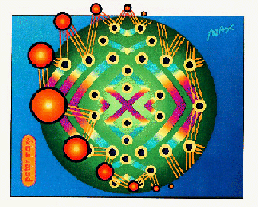NTIA at 45: Building on Generations of Innovation
By Christopher Maximos, Intern in the Office of Congressional Affairs
I still remember the sense of wonder that I felt when I entered the Herbert Clark Hoover Building for the first day of my internship. I could almost feel the history of the Department of Commerce as I walked through meeting rooms filled with antiques and hallways blanketed by the portraits of previous Secretaries.
Yet, the fourth floor, where most of the National Telecommunications and Information Administration’s offices sit, is different. Colorful spectrum charts blanket the timeless marble walls. Staffers discuss emerging technologies like artificial intelligence and 5G in rooms that look out to the Washington Monument and the White House.
My co-intern, Quentin Stalker, and I have been especially cognizant of NTIA’s history over the past month, in the run-up to the agency’s 45th anniversary. On March 27th, 1978, President Carter signed Executive Order 12046, which effectively transferred authority over telecommunications policy from the Executive Office of the President to the Department of Commerce. This executive order laid the foundations for NTIA, which officially opened its doors in May of that year — roughly 45 days after that executive order’s signature.
To celebrate NTIA’s four-and-a-half-decade legacy, Quentin and I compiled 45 facts about the NTIA, spotlighting its line offices, former leadership, current programs, and past accomplishments.
Overall, the fact-finding project has been incredibly enriching. Throughout the research process, I have learned so much about NTIA’s development and gained such a deep appreciation for its contributions. Our fact collection only scratches the surface, NTIA has had a truly transformative impact on Americans’ digital lives. Follow NTIA’s Twitter account to find the 45 facts that are tweeted out daily into May.
I wanted to highlight four takeaways about NTIA’s incredible history that feature some of my favorite facts along the way.
First, NTIA grew and evolved with the advent of new technologies.
The NTIA stands on the shoulders of its two predecessor organizations. President Hoover convened the Interdepartmental Radio Advisory Committee, the first telecommunications-related regulatory body, in 1922 to address the nationwide surge in radio interference. In 1970, President Nixon created the Office of Telecommunications Policy to build a more competitive telecommunications market as phone technology became more accessible.
Since its founding, NTIA has been anything but stagnant. NTIA’s leaders recognize that new technological challenges require new regulatory approaches and organizational structures. Instead of sticking to an entrenched structure, NTIA maintains a “start-up mindset” 45 years on, which allows the agency to keep meeting the moment. In the past decade, NTIA has added the Office of Public Safety Communications, to oversee the creation and development of a first responders’ telecommunications network known as the FirstNet Authority. NTIA has also reorganized another office, the Office of Internet Connectivity and Growth, to support the vision for nationwide high-speed Internet expansion laid out in the Bipartisan Infrastructure Law.
Second, past NTIA administrators have shaped NTIA’s current mission in fundamental ways.
In 1995, NTIA Administrator Larry Irving co-authored “Falling Through the Net,” the first empirical survey of American’s access to information technology. The research revealed critical divides across the country: economically and geographically disadvantaged communities faced barriers to getting online. Administrator Irving’s report brought the “digital divide” into the public consciousness. Over twenty-five years later, NTIA’s banner program, Internet for All, is closing this divide with once-in-a-generation investments in high-speed Internet infrastructure.
More recently, Administrator David Redl and Acting Administrator Diane Rinaldo led the NTIA during the initial rollout of 5G. They recognized the importance of America’s leadership in 5G and introduced initiatives like C-SCRIP, which shares critical supply chain security risk information with trusted suppliers. In 2022, NTIA kicked off the Public Wireless Supply Chain Innovation Fund (Innovation Fund). The projects incubated by the Innovation Fund and the insights that come out of the NTIA’s 5G Challenge will ensure that the U.S. remains a global telecommunications leader for years to come.
Ultimately, great leaders make contributions to organizations that will long outlast their tenures.
Third, NTIA plays pivotal roles in global telecommunications policy and research.
Before coming to NTIA, I knew of its core responsibility — advising the President on telecommunications and information policy — but I was woefully unaware of its contributions to global telecommunications policy.
NTIA helped architect coordination of the Domain Name System (DNS) in the late 1990s, then transitioned its oversight role in 2016. NTIA helps drives the agenda of both CITEL, the Inter-American telecommunications body, and the International Telecommunications Union (ITU). Doreen Bogdan-Martin, an alumna of NTIA, assumed the Secretary General position at the ITU at the beginning of 2023, becoming the first woman to lead the Union in its 157-year history. Clearly, NTIA is well-represented in the most important global conversations on telecommunications.
Similarly, NTIA’s Institute for Telecommunication Sciences (ITS) leads the way in telecommunications research. In 2015, ITS partnered with the Department of Homeland Security in 2015 on a project that helped emergency responders better communicate indoors. The insights from that research are lifesaving: they allow emergency personnel to communicate better with each other and those who need assistance during crisis situations.

Fourth, NTIA has always understood the boundless potential of Internet and telecommunications technology.
The first generations of NTIA employees could not have predicted exactly how information technology would look on NTIA’s 45th anniversary, but they knew it would be, on balance, a source for good. Throughout its history, NTIA has been a first adopter. It sponsored the first virtual hearing on the Internet in 1994. It introduced its website in 1995. In the 2000s, it helped youth access the Internet safely via kids.gov and the .kids domain listing.
NTIA’s techno-optimism is an important antidote to contemporary techno-pessimism. In 1995, famous pop artist Peter Max adorned an NTIA report with his artwork. Max believed that “the global information infrastructure” was “the most significant breakthrough in human techno-progress for the 21st Century.” It’s incredible that he recognized the Internet’s once-in-a-century potential before the century even began.
